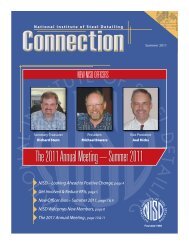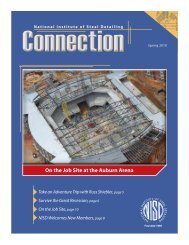Connection
Fall 2008 (PDF) - National Institute of Steel Detailing
Fall 2008 (PDF) - National Institute of Steel Detailing
- No tags were found...
Create successful ePaper yourself
Turn your PDF publications into a flip-book with our unique Google optimized e-Paper software.
The Care and Feeding of Detailers<br />
Overlooked,<br />
misunderstood, and<br />
often maligned,<br />
structural steel detailers<br />
nevertheless<br />
play a critical role<br />
in bringing projects<br />
to life.<br />
by Jack Metcalfe<br />
Usually far from the excitement of steel<br />
members being hoisted by a crane, or far<br />
from the thunder and sparks that come<br />
from the fabrication shop, detailing is<br />
accomplished in relative obscurity. The<br />
detailer is more often than not in a different<br />
city than his client, and perhaps even a<br />
different country. Unless there is a schedule<br />
crisis, an RFI, or a revision, many in<br />
the construction field don’t even know that<br />
detailers exist – or if they do, they think<br />
that it is actually a computer that does all<br />
the drafting and the detailers just push the<br />
buttons. Many old-time contractors and<br />
some inexperienced project managers<br />
believe that detailer drawing rooms are<br />
part of the fabricator’s in-house organization.<br />
Project owners and GCs believe the<br />
detailer is controlled by the fabricator and<br />
is subject to his dictates. They are often<br />
astonished to discover that we detailers<br />
are now, more often than not, an independent<br />
business organization with our own<br />
clients, schedules, overhead, employees,<br />
and sales to worry about. Times have<br />
changed, and the detailer must now wear<br />
many hats, not just that of a “produce or<br />
perish” draftsperson serving one master.<br />
But whether an independent entity or part<br />
of a fab shop, the detailer must still be a<br />
part of the construction team.<br />
Federal Highway Administration<br />
Says Billions Needed for Bridge<br />
Updates<br />
Submitted by Jack Metcalfe<br />
Jack Metcalfe<br />
The Federal Highway Administration estimates<br />
it will cost $140 billion if all the<br />
nation’s 600,000 bridges were repaired or<br />
modernized today. Those figures are part<br />
of a report issued just last week by the<br />
American Association of State and Highway<br />
Transportation Officials (AASHTO).<br />
There is an old adage about how the<br />
more things change, the more they remain<br />
the same. As a detailer who has been privileged<br />
to serve the fabricated steel construction<br />
industry for more than just a few<br />
years, it is tempting to believe that. Sure,<br />
the callus on my finger has diminished<br />
and has been replaced with carpal tunnel,<br />
but the holes in mating material still have<br />
to match. Erection diagrams are now frequently<br />
called “member placement plans,”<br />
but the detailer still has to show the erector<br />
where, and sometimes how, the member<br />
is to be properly located in the structure.<br />
The design drawings may now be issued<br />
in version “eleventy-seven” of someone’s<br />
software, but it is still the detailer who has<br />
to interpret the intent of the design into a<br />
set of zero-defect shop and field drawings.<br />
Changes in design now often come guised<br />
as “approval comments” instead of revisions,<br />
but making the necessary changes to<br />
mill orders or shop and erection drawings<br />
still costs time – and time is still money<br />
no matter how fast electronic changes are<br />
supposed to be. The electronic RFI and<br />
clarification sketch may have replaced<br />
the fax, which replaced snail mail, which<br />
replaced the phone. But all of us in the<br />
construction business still struggle with<br />
costs and delays caused by incomplete or<br />
erroneous design information.<br />
Back in the day, any detailing errors<br />
the checker found would have to be<br />
“scrubbed” by the detailer from his/her<br />
drawing, using a rubber eraser, and the<br />
corrections made manually with a pencil<br />
– an arduous task that made drafters strive<br />
for perfect drawings and consequently<br />
made for better detailers. Now, in most<br />
drawing rooms, it’s done with the CAD<br />
Key findings from the report, “Bridging<br />
the Gap: Restoring and Repairing the Nation’s<br />
Bridges:”<br />
• Age – The average age of the nation’s<br />
bridges is 43 years. Most were built to<br />
last 50 years. Almost 20 percent of what<br />
AASHTO calls “baby boomer” bridges<br />
were built more than 50 years ago. As<br />
age and traffic increase, so does the need<br />
for repair.<br />
• Traffic congestion – Many of the nation’s<br />
large-scale bridges have become<br />
“chokepoints” on the country’s freeway<br />
system, but the work still requires a checker,<br />
and the drafter still has to “back check”<br />
and agree with any checker’s corrections<br />
before fixing the drawing.<br />
And I’m sure that many high-tech gurus<br />
would be surprised to learn that there are<br />
still a number of highly skilled manual<br />
drawing rooms in existence, turning out<br />
some very sophisticated work. (I can<br />
remember when a mouse was something<br />
that snuck into your drafting table drawer<br />
and made a nest in the pencil shavings.)<br />
At one time, the only names we had to<br />
be familiar with were Smolley, Bruhn,<br />
Inskip, Webster, our squad boss, and the<br />
paymaster. Now, we have to know HP,<br />
Dell, Jobber, Blodgett, Gates, and Google.<br />
But regardless of who you know, what you<br />
know is still the trademark of a quality<br />
detailer. How many other craftspeople<br />
have to be knowledgeable in estimating,<br />
welding, scheduling, mathematics,<br />
scheduling, connections development,<br />
spatial concepts, camber, scheduling, mill<br />
practices, scheduling, graphics, tension,<br />
compression, scheduling, overhead, erection<br />
techniques, sales, computers, scheduling,<br />
estimating, paint systems, partnering,<br />
design-build, and OSHA – not to mention<br />
scheduling?<br />
I would suggest that you visit a detailer<br />
– or talk to a group like AISC, NISD, or<br />
SEAA, all of whom will be happy to share<br />
with you their knowledge of this littleknown<br />
but highly important member of<br />
the steel construction team.<br />
First printed in Modern Steel Construction,<br />
June 2008.<br />
system and a drain on the nation’s economy.<br />
The top 10 highway interchange<br />
bottlenecks cause an average of 1.5 million<br />
truck hours of delay each year.<br />
• Soaring construction costs – The costs<br />
of steel, asphalt, concrete and earthwork<br />
have risen by at least 50 percent in the<br />
past five years, forcing delays of bridge<br />
improvements and replacements. Nearly<br />
every state faces funding shortages that<br />
prevent them from ongoing preventive<br />
maintenance, repair and replacement<br />
needed to keep their bridges sound<br />
indefinitely.<br />
16<br />
National Institute of Steel Detailing<br />
Fall 2008 • <strong>Connection</strong>





